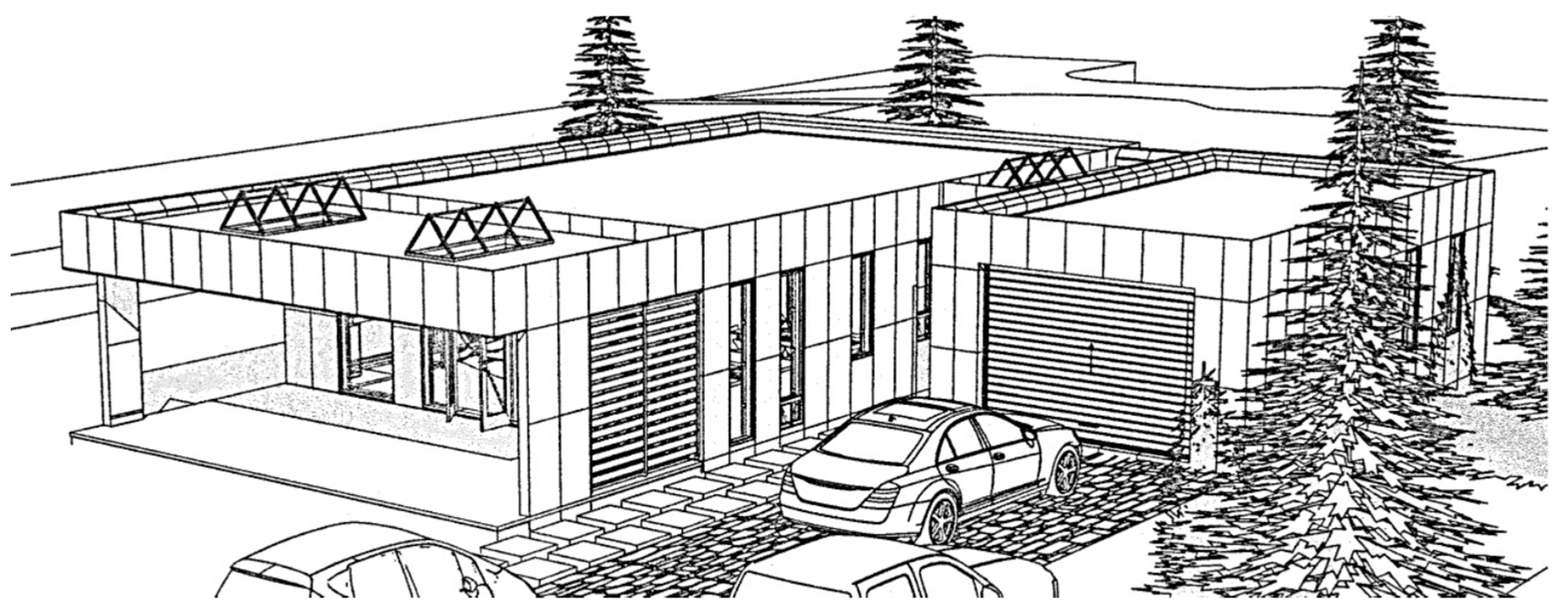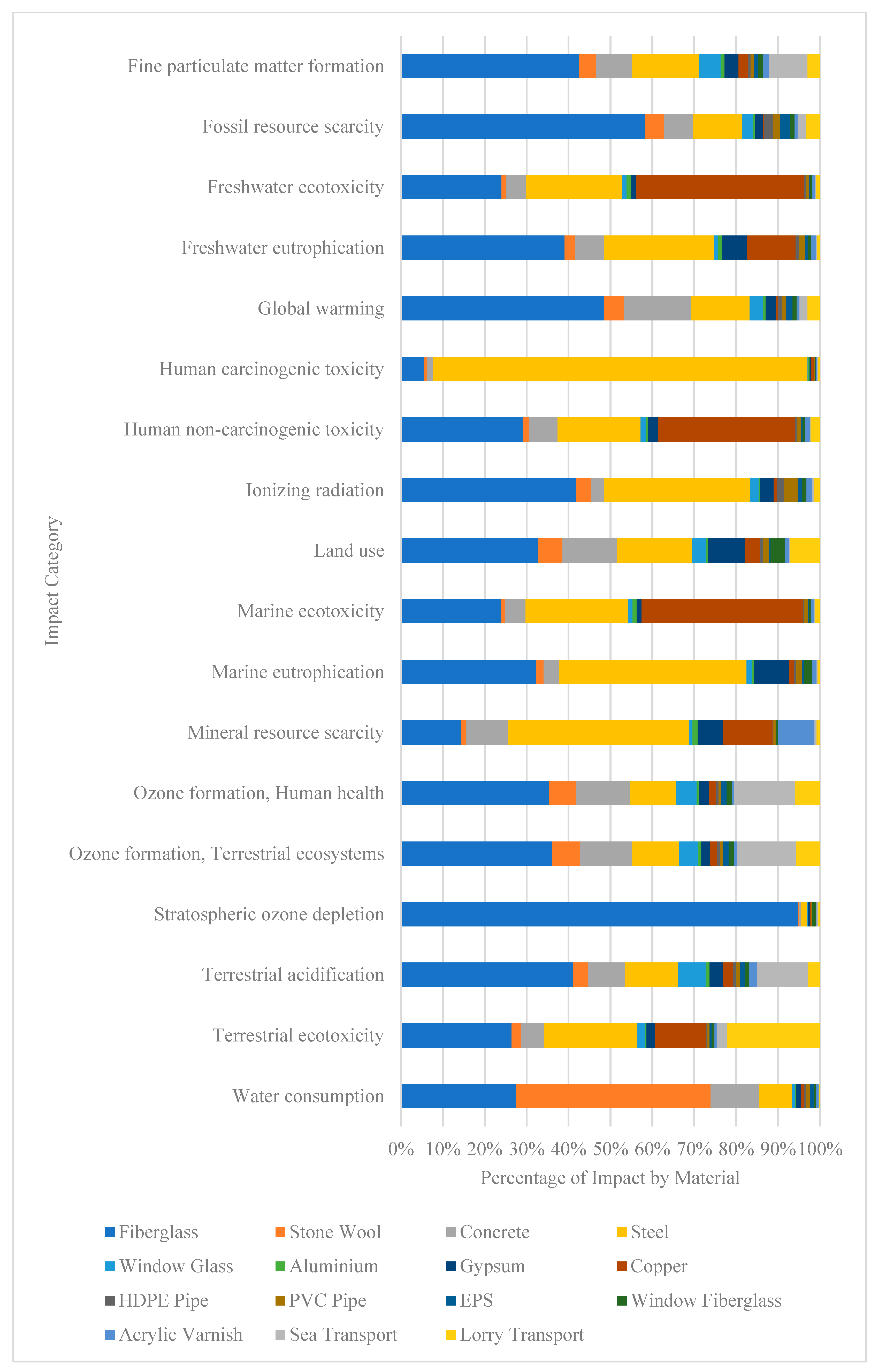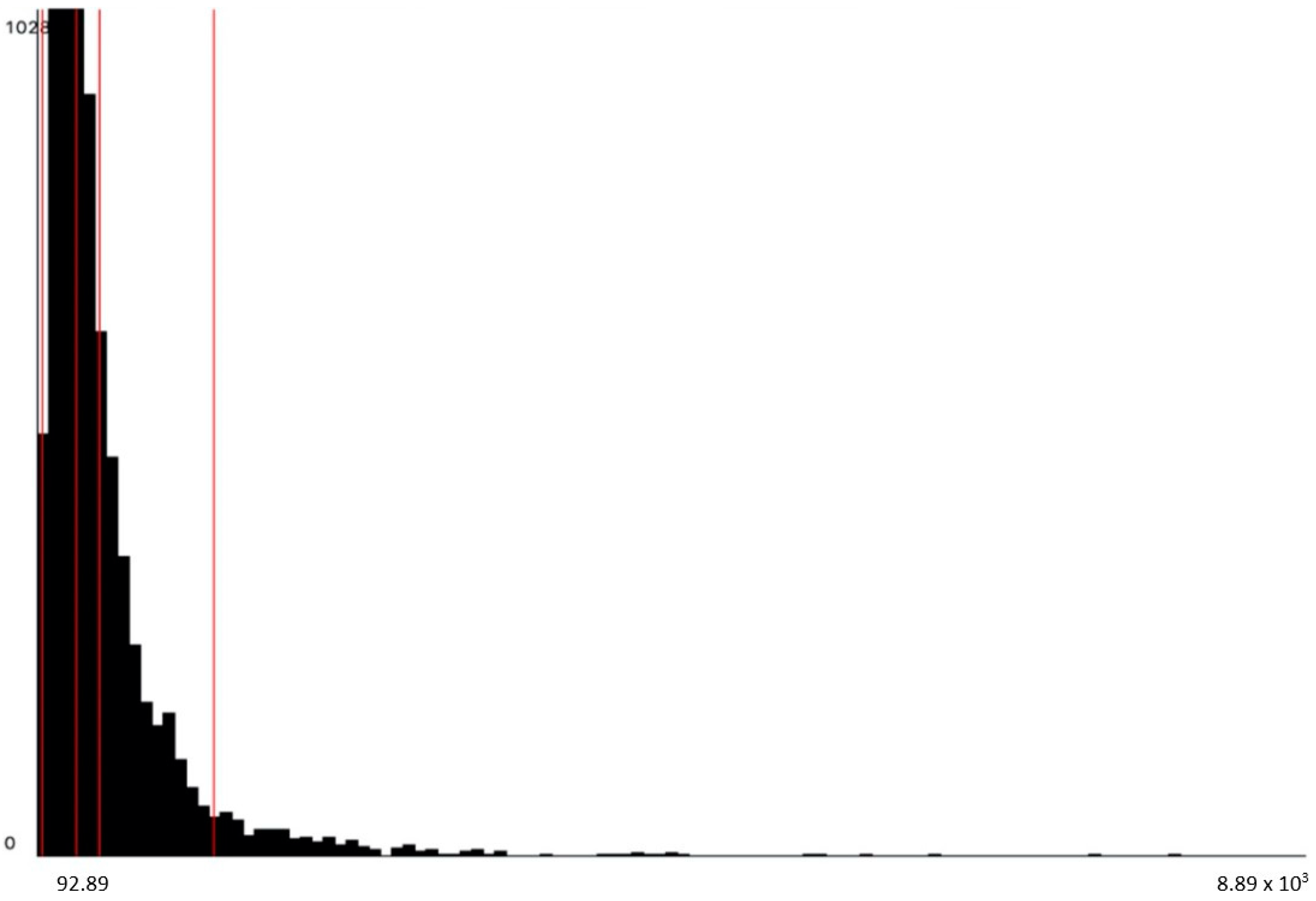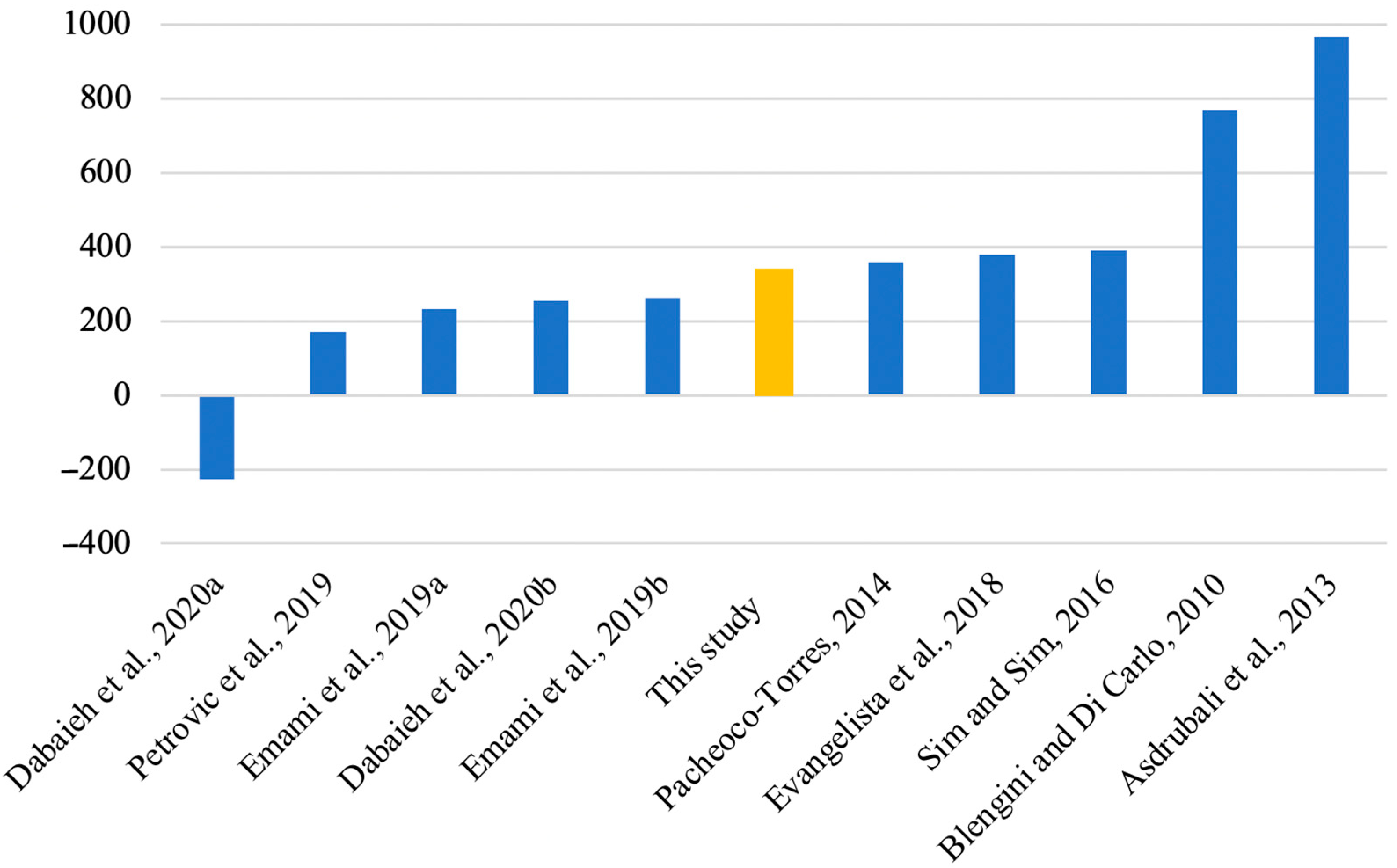Fiberglass as a Novel Building Material: A Life Cycle Assessment of a Pilot House
Abstract
:1. Introduction
2. Materials and Methods
2.1. Description of the Fiberglass House Case
2.1.1. Fiberglass Panels
2.1.2. Support Structure
2.2. Method
2.3. Research Process
2.3.1. Goal and Scope
2.3.2. Pre-Use Phase Life Cycle Inventory
2.3.3. Use Phase
2.3.4. Life Cycle Impact Assessment
2.3.5. Uncertainty Analysis
3. Results
3.1. Midpoint Results
3.2. Midpoint Hotspot Analysis by Materials
Most Contributing Materials to GWP
3.3. Uncertainty Analysis
3.4. Endpoint Results
3.5. Use Phase
4. Discussion and Conclusions
Author Contributions
Funding
Institutional Review Board Statement
Informed Consent Statement
Data Availability Statement
Acknowledgments
Conflicts of Interest
Appendix A
| Material Name | Quantity | Unit |
|---|---|---|
| Glass fiber | 0.19 | kg |
| Modar NX resin | 0.785 | kg |
| Neulon LP 85 additive | 0.025 | kg |
| Maxgaurd FRX Gelcoat | 0.216 | kg |
| Process | Process Name in OpenLCA | Source | Geographical Coverage | Year | Modeling Adjustments |
|---|---|---|---|---|---|
| Fiberglass | Custom process | ecoinvent | 2020 | ||
| Maxgaurd FRX Gelcoat | epoxy resin production, liquid | epoxy resin, liquid | Cutoff, U—RER | ecoinvent | Poland | 2020 | Modified ecoinvent process from European to Poland by changing electricity process |
| Neulon LP 85 additive | ethylene vinyl acetate copolymer production | ethylene vinyl acetate copolymer | Cutoff, U—RER | ecoinvent | Poland | 2019 | Modified ecoinvent process from European to Poland by changing electricity process |
| Glass fiber | glass fibre production | glass fibre | Cutoff, U—RoW | ecoinvent | China | 2019 | Modified ecoinvent process from Rest of the World to China by changing the electricity process to CN, tap water process to RoW, and heat process to RoW |
| Modar NX Resin | polyester resin production, unsaturated | polyester resin, unsaturated | Cutoff, U—RER | ecoinvent | Spain | 2019 | Modified ecoinvent process from European to Spain by changing the electricity process |
References
- Boyle, A. Climate Change, Sustainable Development, and Human Rights; Springer: Cham, Switzerland, 2020. [Google Scholar]
- Steffen, W.; Broadgate, W.; Deutsch, L.; Gaffney, O.; Ludwig, C. The trajectory of the Anthropocene: The Great Acceleration. Anthr. Rev. 2015, 2, 81–98. [Google Scholar] [CrossRef]
- Global Alliance for Buildings and Construction, International Energy Agency. 2020 Global Status Report for Buildings and Construction. 2020. Available online: https://globalabc.org/sites/default/files/inline-files/2020%20Buildings%20GSR_FULL%20REPORT.pdf (accessed on 1 August 2022).
- Röck, M.; Saade, M.R.M.; Balouktsi, M.; Rasmussen, F.N.; Birgisdottir, H.; Frischknecht, R.; Habert, G.; Lützkendorf, T.; Passer, A. Embodied GHG emissions of buildings—The hidden challenge for effective climate change mitigation. Appl. Energy 2019, 258, 114107. [Google Scholar] [CrossRef]
- Nwodo, M.; Anumba, C.J. A review of life cycle assessment of buildings using a systematic approach. Build. Environ. 2019, 162, 106290. [Google Scholar] [CrossRef]
- Säynäjoki, A.; Heinonen, J.; Junnonen, J.-M.; Junnila, S. Input–output and process LCAs in the building sector: Are the results compatible with each other? Carbon Manag. 2017, 8, 155–166. [Google Scholar] [CrossRef]
- Säynäjoki, A.; Heinonen, J.; Junnila, S. A scenario analysis of the life cycle greenhouse gas emissions of a new residential area. Environ. Res. Lett. 2012, 7, 034037. [Google Scholar] [CrossRef]
- Ramesh, T.; Prakash, R.; Shukla, K.K. Life cycle energy analysis of buildings: An overview. Energy Build. 2010, 42, 1592–1600. [Google Scholar] [CrossRef]
- Verbeeck, G.; Hens, H. Life cycle inventory of buildings: A contribution analysis. Build. Environ. 2010, 45, 964–967. [Google Scholar] [CrossRef]
- Gustavsson, L.; Joelsson, A. Life cycle primary energy analysis of residential buildings. Energy Build. 2010, 42, 210–220. [Google Scholar] [CrossRef]
- Wells, L.; Rismanchi, B.; Aye, L. A review of Net Zero Energy Buildings with reflections on the Australian context. Energy Build. 2018, 158, 616–628. [Google Scholar] [CrossRef]
- Crawford, R.H.; Bartak, E.L.; Stephan, A.; Jensen, C.A. Evaluating the life cycle energy benefits of energy efficiency regulations for buildings. Renew. Sustain. Energy Rev. 2016, 63, 435–451. [Google Scholar] [CrossRef]
- Amiri, A.; Ottelin, J.; Sorvari, J.; Junnila, S. Cities as carbon sinks—Classification of wooden buildings. Environ. Res. Lett. 2020, 15, 094076. [Google Scholar] [CrossRef]
- Kuittinen, M.; Zernicke, C.; Slabik, S.; Hafner, A. How can carbon be stored in the built environment? A review of potential options. Arch. Sci. Rev. 2021, 1–17. [Google Scholar] [CrossRef]
- Heinonen, J.; Säynäjoki, A.; Junnonen, J.-M.; Pöyry, A.; Junnila, S. Pre-use phase LCA of a multi-story residential building: Can greenhouse gas emissions be used as a more general environmental performance indicator? Build. Environ. 2016, 95, 116–125. [Google Scholar] [CrossRef] [Green Version]
- Hoxha, E.; Passer, A.; Saade, M.R.M.; Trigaux, D.; Shuttleworth, A.; Pittau, F.; Allacker, K.; Habert, G. Biogenic carbon in buildings: A critical overview of LCA methods. Build. Cities 2020, 1, 504–524. [Google Scholar] [CrossRef]
- Ben-Alon, L.; Loftness, V.; Harries, K.; Hameen, E.C. Life cycle assessment (LCA) of natural vs conventional building assemblies. Renew. Sustain. Energy Rev. 2021, 144, 110951. [Google Scholar] [CrossRef]
- Cabeza, L.F.; Barreneche, C.; Miró, L.; Morera, J.M.; Bartolí, E.; Fernández, A.I. Low carbon and low embodied energy materials in buildings: A review. Renew. Sustain. Energy Rev. 2013, 23, 536–542. [Google Scholar] [CrossRef]
- Dabaieh, M.; Emami, N.; Heinonen, J.T.; Marteinsson, B. A life cycle assessment of a ‘minus carbon’ refugee house: Global warming potential and sensitivity analysis. Archnet-IJAR Int. J. Arch. Res. 2020, 14, 559–579. [Google Scholar] [CrossRef]
- Dabaieh, M.; Heinonen, J.; El-Mahdy, D.; Hassan, D.M. A comparative study of life cycle carbon emissions and embodied energy between sun-dried bricks and fired clay bricks. J. Clean. Prod. 2020, 275, 122998. [Google Scholar] [CrossRef]
- Işildar, G.Y.; Morsali, S.; Gari, Z.H.Z. A comparison LCA of the common steel rebars and FRP. J. Build. Pathol. Rehabil. 2020, 5, 8. [Google Scholar] [CrossRef]
- Pacheco-Torres, R.; Jadraque, E.; Roldán-Fontana, J.; Ordóñez, J. Analysis of CO2 emissions in the construction phase of single-family detached houses. Sustain. Cities Soc. 2014, 12, 63–68. [Google Scholar] [CrossRef]
- Gong, X.; Nie, Z.; Wang, Z.; Cui, S.; Gao, F.; Zuo, T. Life Cycle Energy Consumption and Carbon Dioxide Emission of Residential Building Designs in Beijing. J. Ind. Ecol. 2012, 16, 576–587. [Google Scholar] [CrossRef]
- Anand, C.K.; Amor, B. Recent developments, future challenges and new research directions in LCA of buildings: A critical review. Renew. Sustain. Energy Rev. 2017, 67, 408–416. [Google Scholar] [CrossRef]
- Khasreen, M.M.; Banfill, P.F.G.; Menzies, G.F. Life-Cycle Assessment and the Environmental Impact of Buildings: A Review. Sustainability 2009, 1, 674–701. [Google Scholar] [CrossRef]
- Igos, E.; Benetto, E.; Meyer, R.; Baustert, P.; Othoniel, B. How to treat uncertainties in life cycle assessment studies? Int. J. Life Cycle Assess. 2018, 24, 794–807. [Google Scholar] [CrossRef]
- Guo, M.; Murphy, R. LCA data quality: Sensitivity and uncertainty analysis. Sci. Total Environ. 2012, 435–436, 230–243. [Google Scholar] [CrossRef] [PubMed]
- Bamber, N.; Turner, I.; Arulnathan, V.; Li, Y.; Ershadi, S.Z.; Smart, A.; Pelletier, N. Comparing sources and analysis of uncertainty in consequential and attributional life cycle assessment: Review of current practice and recommendations. Int. J. Life Cycle Assess. 2019, 25, 168–180. [Google Scholar] [CrossRef] [Green Version]
- Groen, E.; Heijungs, R.; Bokkers, E.; de Boer, I. Methods for uncertainty propagation in life cycle assessment. Environ. Model. Softw. 2014, 62, 316–325. [Google Scholar] [CrossRef]
- Chandrasekaran, V.; Dvarioniene, J.; Vitkute, A.; Gecevicius, G. Environmental Impact Assessment of Renovated Multi-Apartment Building Using LCA Approach: Case Study from Lithuania. Sustainability 2021, 13, 1542. [Google Scholar] [CrossRef]
- Morales, M.F.; Passuello, A.; Kirchheim, A.P.; Ries, R.J. Monte Carlo parameters in modeling service life: Influence on life-cycle assessment. J. Build. Eng. 2021, 44, 103232. [Google Scholar] [CrossRef]
- Ögmundarson, Ó.; Sukumara, S.; Laurent, A.; Fantke, P. Environmental hotspots of lactic acid production systems. GCB Bioenergy 2019, 12, 19–38. [Google Scholar] [CrossRef]
- Hjaltason, P. A02 Útlit (Verknr. 1709, Breyting 02) [Architectural Drawing]. 2020. Available online: https://www.map.is/grindavik/ (accessed on 3 December 2021).
- Minunno, R.; O’Grady, T.; Morrison, G.M.; Gruner, R.L.; Colling, M. Strategies for Applying the Circular Economy to Prefabricated Buildings. Buildings 2018, 8, 125. [Google Scholar] [CrossRef] [Green Version]
- Guinée, J.; De Haes, H.U.; Huppes, G. Quantitative life cycle assessment of products: 1:Goal definition and inventory. J. Clean. Prod. 1993, 1, 3–13. [Google Scholar] [CrossRef]
- ISO Standard No. 14044; Environmental Management-Life Cycle Assessment-Requirements and Guidelines. International Organization for Standardization: Geneva, Switzerland, 2006.
- United States Environmental Protection Agency. Life Cycle Assessment: Principals and Practice; National Risk Management Research Laboratory: Cincinnati, OH, USA, 2006; pp. 4–5. Available online: https://nepis.epa.gov/Exe/ZyPDF.cgi/P1000L86.PDF?Dockey=P1000L86.PDF (accessed on 29 August 2020).
- Buyle, M.; Braet, J.; Audenaert, A. Life cycle assessment in the construction sector: A review. Renew. Sustain. Energy Rev. 2013, 26, 379–388. [Google Scholar] [CrossRef]
- Crawford, R.H.; Bontinck, P.-A.; Stephan, A.; Wiedmann, T.; Yu, M. Hybrid life cycle inventory methods—A review. J. Clean. Prod. 2018, 172, 1273–1288. [Google Scholar] [CrossRef]
- Teh, S.H.; Wiedmann, T.; Moore, S. Mixed-unit hybrid life cycle assessment applied to the recycling of construction materials. J. Econ. Struct. 2018, 7, 13. [Google Scholar] [CrossRef] [Green Version]
- EN 15804:2012flA1; Sustainability of Construction Works, Environmental Product Declarations. Core Rules for the Product Category of Construction Products. U.S. Green Building Council: Washington, DC, USA, 2012.
- Passive House Institute. Criteria for the Passive House, EnerPHit and PHI Low Energy Building Standard. 2016. Available online: https://passiv.de/downloads/03_building_criteria_en.pdf (accessed on 15 September 2021).
- Karlsdottir, M.R.; Heinonen, J.; Palsson, H.; Palsson, O.P. Life cycle assessment of a geothermal combined heat and power plant based on high temperature utilization. Geothermics 2019, 84, 101727. [Google Scholar] [CrossRef]
- European Energy Agency. Energy Intensity in Europe. 2020. Available online: https://www.eea.europa.eu/data-and-maps/indicators/total-primary-energyintensity-4/assessment-1 (accessed on 9 May 2021).
- Reykjavik Energy. Annual Report 2018. 2018. Available online: https://annualreport2018.or.is/loftslagsm%C3%A1l/ (accessed on 9 May 2021).
- Fazeli, R.; Davidsdottir, B. Energy performance of dwelling stock in Iceland: System dynamics approach. J. Clean. Prod. 2017, 167, 1345–1353. [Google Scholar] [CrossRef]
- Rousselot, M. Energy Efficiency Trends in Buildings (Rep.). 2018. Available online: https://www.odysseemure.eu/publications/policy-brief/buildings-energy-efficiency-trends.html (accessed on 10 February 2021).
- Buildings Performance Institute Europe. Financing Building Energy Performance Improvement in Poland (Rep.). 2016. Available online: http://bpie.eu/wpcontent/uploads/2016/01/BPIE_Financing-building-energy-in-Poland_EN.pdf (accessed on 10 February 2021).
- European Commission. European Climate Law. 2021. Available online: https://ec.europa.eu/clima/policies/eu-climate-action/law_en (accessed on 9 May 2021).
- Government of Iceland. Iceland’s 2020 Climate Action Plan. 2020. Available online: https://www.government.is/library/01-Ministries/Ministry-for-TheEnvironment/201004%20Umhverfisraduneytid%20Adgerdaaaetlun%20EN%20V2.pdf (accessed on 9 May 2021).
- Government of Iceland. Energy. 2015. Available online: https://www.government.is/topics/business-and-industry/energy/ (accessed on 29 August 2020).
- Sigfússon, B.; Arnarson, M.; Snæbjörnsdóttir, S.; Karlsdóttir, M.R.; Aradóttir, E.S.; Gunnarsson, I. Reducing emissions of carbon dioxide and hydrogen sulphide at Hellisheidi power plant in 2014–2017 and the role of CarbFix in achieving the 2040 Iceland climate goals. Energy Procedia 2018, 146, 135–145. [Google Scholar] [CrossRef]
- Ecoinvent. About Ecoinvent. 2021. Available online: https://www.ecoinvent.org/about/about.html (accessed on 29 September 2021).
- Huijbregts, M.A.J.; Steinmann, Z.J.N.; Elshout, P.M.F.; Stam, G.; Verones, F.; Vieira, M.; Zijp, M.; Hollander, A.; van Zelm, R. ReCiPe2016: A harmonised life cycle impact assessment method at midpoint and endpoint level. Int. J. Life Cycle Assess. 2017, 22, 138–147. [Google Scholar] [CrossRef]
- Goedkoop, M.; Heijungs, R.; Huijbregts, M.; Schryver, A.; Struijs, J.; Zelm, R. ReCiPE 2008: A Life Cycle Impact Assessment Method Which Comprises Harmonised Category Indicators at the Midpoint and the Endpoint Level; Ruimte Enmilieu, Ministerie Van Volkshuisvesting, Tuimtelijke Ordening en Milieubeheer: Den Haag, The Netherlands, 2008. [Google Scholar]
- Emami, N.; Heinonen, J.; Marteinsson, B.; Säynäjoki, A.; Junnonen, J.-M.; Laine, J.; Junnila, S. A Life Cycle Assessment of Two Residential Buildings Using Two Different LCA Database-Software Combinations: Recognizing Uniformities and Inconsistencies. Buildings 2019, 9, 20. [Google Scholar] [CrossRef]
- Skullestad, J.L.; Bohne, R.A.; Lohne, J. High-rise Timber Buildings as a Climate Change Mitigation Measure—A Comparative LCA of Structural System Alternatives. Energy Procedia 2016, 96, 112–123. [Google Scholar] [CrossRef] [Green Version]
- Dong, Y.; Ng, S.T. Comparing the midpoint and endpoint approaches based on ReCiPe—A study of commercial buildings in Hong Kong. Int. J. Life Cycle Assess. 2014, 19, 1409–1423. [Google Scholar] [CrossRef]
- Bare, J.C.; Hofstetter, P.; Pennington, D.W.; De Haes, H.A.U. Midpoints versus endpoints: The sacrifices and benefits. Int. J. Life Cycle Assess. 2000, 5, 319. [Google Scholar] [CrossRef] [Green Version]
- Heijungs, R. On the number of Monte Carlo runs in comparative probabilistic LCA. Int. J. Life Cycle Assess. 2019, 25, 394–402. [Google Scholar] [CrossRef] [Green Version]
- Rockström, J.; Steffen, W.; Noone, K.; Persson, Å.; Chapin, F.S., III; Lambin, E.F.; Lenton, T.M.; Scheffer, M.; Folke, C.; Schellnhuber, H.J.; et al. A safe operating space for humanity. Nature 2009, 461, 472–475. [Google Scholar] [CrossRef] [PubMed]
- Laurent, A.; Olsen, S.I.; Hauschild, M.Z. Normalization in EDIP97 and EDIP2003: Updated European inventory for 2004 and guidance towards a consistent use in practice. Int. J. Life Cycle Assess. 2011, 16, 401–409. [Google Scholar] [CrossRef]
- Pizzol, M.; Christensen, P.; Schmidt, J.; Thomsen, M. Impacts of “metals” on human health: A comparison between nine different methodologies for Life Cycle Impact Assessment (LCIA). J. Clean. Prod. 2011, 19, 646–656. [Google Scholar] [CrossRef]
- Fantke, P.; Aylward, L.; Bare, J.; Chiu, W.A.; Dodson, R.; Dwyer, R.; Ernstoff, A.; Howard, B.; Jantunen, M.; Jolliet, O.; et al. Advancements in Life Cycle Human Exposure and Toxicity Characterization. Environ. Health Perspect. 2018, 126, 125001. [Google Scholar] [CrossRef]
- Hou, P.; Jolliet, O.; Zhu, J.; Xu, M. Estimate ecotoxicity characterization factors for chemicals in life cycle assessment using machine learning models. Environ. Int. 2019, 135, 105393. [Google Scholar] [CrossRef]
- Westh, T.B.; Hauschild, M.Z.; Birkved, M.; Jørgensen, M.S.; Rosenbaum, R.K.; Fantke, P. The USEtox story: A survey of model developer visions and user requirements. Int. J. Life Cycle Assess. 2014, 20, 299–310. [Google Scholar] [CrossRef]
- Dahlbo, H.; Koskela, S.; Pihkola, H.; Nors, M.; Federley, M.; Seppälä, J. Comparison of different normalised LCIA results and their feasibility in communication. Int. J. Life Cycle Assess. 2012, 18, 850–860. [Google Scholar] [CrossRef]
- Duflou, J.R.; Deng, Y.; Van Acker, K.; Dewulf, W. Do fiber-reinforced polymer composites provide environmentally benign alternatives? A life-cycle-assessment-based study. MRS Bull. 2012, 37, 374–382. [Google Scholar] [CrossRef] [Green Version]
- Suh, S.; Lenzen, M.; Treloar, G.J.; Hondo, H.; Horvath, A.; Huppes, G.; Jolliet, O.; Klann, U.; Krewitt, W.; Moriguchi, Y.; et al. System Boundary Selection in Life-Cycle Inventories Using Hybrid Approaches. Environ. Sci. Technol. 2003, 38, 657–664. [Google Scholar] [CrossRef] [PubMed]
- Silva, V.; Pulgrossi, L. When part is too little: Cutoff rules’ influence on LCA application to whole-building studies. In Proceedings of the Windsor 2020: Resilient Comfort, Windsor, UK, 16–19 April 2020. [Google Scholar]
- Joensuu, T.; Leino, R.; Heinonen, J.; Saari, A. Developing Buildings’ Life Cycle Assessment in Circular Economy-Comparing methods for assessing carbon footprint of reusable components. Sustain. Cities Soc. 2021, 77, 103499. [Google Scholar] [CrossRef]
- Petrovic, B.; Myhren, J.A.; Zhang, X.; Wallhagen, M.; Eriksson, O. Life Cycle Assessment of Building Materials for a Single-family House in Sweden. Energy Procedia 2019, 158, 3547–3552. [Google Scholar] [CrossRef]
- Evangelista, P.P.; Kiperstok, A.; Torres, E.A.; Gonçalves, J.P. Environmental performance analysis of residential buildings in Brazil using life cycle assessment (LCA). Constr. Build. Mater. 2018, 169, 748–761. [Google Scholar] [CrossRef]
- Sim, J.; Sim, J. The air emission assessment of a South Korean traditional building during its life cycle. Build. Environ. 2016, 105, 283–294. [Google Scholar] [CrossRef]
- Asdrubali, F.; Baldassarri, C.; Fthenakis, V. Life cycle analysis in the construction sector: Guiding the optimization of conventional Italian buildings. Energy Build. 2013, 64, 73–89. [Google Scholar] [CrossRef]
- Blengini, G.A.; Di Carlo, T. Energy-saving policies and low-energy residential buildings: An LCA case study to support decision makers in Piedmont (Italy). Int. J. Life Cycle Assess. 2010, 15, 652–665. [Google Scholar] [CrossRef]
- Ruuska, A.P.; Häkkinen, T.M. The significance of various factors for GHG emissions of buildings. Int. J. Sustain. Eng. 2014, 8, 317–330. [Google Scholar] [CrossRef]
- Takano, A.; Hughes, M.; Winter, S. A multidisciplinary approach to sustainable building material selection: A case study in a Finnish context. Build. Environ. 2014, 82, 526–535. [Google Scholar] [CrossRef]
- Heinonen, J.; Junnila, S. Residential energy consumption patterns and the overall housing energy requirements of urban and rural households in Finland. Energy Build. 2014, 76, 295–303. [Google Scholar] [CrossRef]










| Gross floor area | 186 m2 |
| Heated area | 106 m2 |
| Mass | 130 t |
| Construction year | 2020 |
| Building Systems | Main Materials |
|---|---|
| 1. Foundations | |
| Walls | Concrete, steel reinforcement |
| Ground Slab | Concrete, steel reinforcement |
| Insulation | Expanded polystyrene (EPS) |
| 2. Frame and roof structures | |
| Support | Steel, fiberglass |
| External walls | Fiberglass panels–fiberglass, stone wool |
| Internal Walls | Fiberglass panels–fiberglass, stone wool |
| Roof | Fiberglass panels–fiberglass, stone wool |
| Insulation | Stone wool |
| 3. Complementary works | |
| Windows | Double-pane, fiberglass frame |
| Internal doors | Double-pane, fiberglass frame |
| External doors | Double-pane, fiberglass frame |
| 4. Finishes | |
| Gypsum | Gypsum fiberboard |
| Interior and exterior paint | Acrylic paint |
| 5. Mechanical works | |
| Floor heating | High-density polyethylene (HDPE) pipe |
| Plumbing | HDPE pipe, polyvinyl chloride (PVC) pipe |
| Electrical | HDPE pipe, PVC pipe, aluminum, copper, steel |
| Material | Building Total (kg) | Total per FU (kg/m2) | Assumed Density (kg/m3) |
|---|---|---|---|
| Concrete | 100,800 | 542 | 2252 |
| Fiberglass | 4339 | 23.3 | - |
| Glass fiber | 824 | 4.4 | 344.5 |
| Modar NX Resin | 3406 | 18.3 | 1700 |
| Neulon LP 85 additive | 108 | 0.6 | 1000 |
| Maxgaurd FRX Gelcoat | 937 | 5 | - |
| Rockwool (stone wool) | 9140 | 49 | 80 |
| Fermacell gypsum fiber board | 9158 | 49 | 1180 |
| EPS | 194 | 1.04 | 30 |
| Window/door glass | 1585 | 8.5 | - |
| Fiberglass window/door frame | 146 | 0.8 | - |
| Steel | 2580 | 13.9 | 7850 |
| HDPE Pipe | 215 | 1.2 | 940 |
| PVC Pipe | 254 | 1.4 | 1467 |
| Aluminum pipes, tracks | 22 | 0.1 | 2700 |
| Copper wire | 38 | 0.2 | 8960 |
| Interior acrylic paint | 40 | 0.2 | - |
| Exterior paint | 140 | 0.8 | - |
| Total | 129,587 | 696 |
| kg CO2 eq/kWh (Year 1) | Energy Consumption Scenario 1 (kWh/m2/yr) | Energy Consumption Scenario 2 (kWh/m2/yr) | ||||
|---|---|---|---|---|---|---|
| Heat | Elec. | Heat | Elec. | Heat | Elec. | |
| Iceland | 0.01 | 0.009 | 44 | 70 | 15 | 45 |
| Poland | 0.4 | 0.7 | 23 | 70 | 15 | 45 |
| Finland | 0.2 | 0.08 | 26 | 70 | 15 | 45 |
| Name | Unit | Total Results per FU (5th–95th Percentile) |
|---|---|---|
| Climate change | kg CO2 eq | 311 (178–1445) |
| Fine particulate matter formation | kg PM2.5 eq | 0.4 (0.3–2) |
| Fossil resource scarcity | kg oil eq | 93 (52–463) |
| Freshwater ecotoxicity | kg 1.4-DCB | 20 (18–101) |
| Freshwater eutrophication | kg P eq | 0.08 (0.05–0.5) |
| Human carcinogenic toxicity | kg 1.4-DCB | 127 (69–520) |
| Human non-carcinogenic toxicity | kg 1.4-DCB | 229 (201–1686) |
| Ionizing radiation | kBq Co-60 eq | 16 (5–178) |
| Land use | m2a crop eq | 7 (5–34) |
| Marine ecotoxicity | kg 1.4-DCB | 26 (24–132) |
| Marine eutrophication | kg N eq | 0.01 (0.007–0.04) |
| Mineral resource scarcity | kg Cu eq | 2 (1–6) |
| Ozone formation, Human health | kg NOx eq | 0.8 (0.5–3) |
| Ozone formation, Terrestrial ecosystems | kg NOx eq | 0.9 (0.6–3) |
| Stratospheric ozone depletion | kg CFC11 eq | 0.001 (0.0002–0.01) |
| Terrestrial acidification | kg SO2 eq | 1 (0.6–4) |
| Terrestrial ecotoxicity | kg 1.4-DCB | 595 (526–2404) |
| Water consumption | m3 | 8 (−491–347) |
| LCA Area of Protection | Unit | Result |
|---|---|---|
| Damage to ecosystems | species.yr | 1.44 × 10−6 |
| Damage to human health | DALY | 1.07 × 10−3 |
| Damage to resource availability | USD2013 | 3.1 × 10 |
| LCA Area of Protection | Unit | Result |
|---|---|---|
| Damage to ecosystems | Pt | 4.11 × 10−7 |
| Damage to human health | Pt | 1 × 10−2 |
| Damage to resource availability | Pt | 1.76 × 108 |
| Single Score | Pt | 1.76 × 108 |
| Study | Location | Floor Area (m2) | Main Materials |
|---|---|---|---|
| Dabaieh et al. [19] | Sweden | 37 | Plant-based |
| Emami et al. [56] | Finland | 149 | Wood |
| Petrovic et al. [62] | Sweden | 180 | Wood |
| Evangelista et al. [63] | Brazil | 56 | Concrete |
| Sim & Sim, [64] | Korea | 77 | Wood |
| Pacheco-Torres et al. [22] | Spain | 313 | Concrete, steel |
| Asdrubali et al. [65] | Italy | 443 | Concrete |
| Blengini & Di Carlo, [66] | Italy | 376 | Concrete, brick |
| Study | Building Type | Size (m2) | Frame and Wall |
|---|---|---|---|
| Ruuska & Häkkinen, [67] | Apartment building | 3056 | Reinforced concrete |
| Takano et al. [68] | Detached | 1243 | Lightweight timber panel |
| Takano et al. [68] | Detached | 1243 | Cross-laminated timber |
| Takano et al. [68] | Detached | 1243 | Reinforced concrete |
| Takano et al. [68] | Detached | 1243 | Steel |
| Heinonen et al. [15] | Apartment building | 3085 | Reinforced concrete |
Publisher’s Note: MDPI stays neutral with regard to jurisdictional claims in published maps and institutional affiliations. |
© 2022 by the authors. Licensee MDPI, Basel, Switzerland. This article is an open access article distributed under the terms and conditions of the Creative Commons Attribution (CC BY) license (https://creativecommons.org/licenses/by/4.0/).
Share and Cite
Bjånesøy, S.; Heinonen, J.; Ögmundarson, Ó.; Árnadóttir, Á.; Marteinsson, B. Fiberglass as a Novel Building Material: A Life Cycle Assessment of a Pilot House. Architecture 2022, 2, 690-710. https://doi.org/10.3390/architecture2040037
Bjånesøy S, Heinonen J, Ögmundarson Ó, Árnadóttir Á, Marteinsson B. Fiberglass as a Novel Building Material: A Life Cycle Assessment of a Pilot House. Architecture. 2022; 2(4):690-710. https://doi.org/10.3390/architecture2040037
Chicago/Turabian StyleBjånesøy, Stavroula, Jukka Heinonen, Ólafur Ögmundarson, Áróra Árnadóttir, and Björn Marteinsson. 2022. "Fiberglass as a Novel Building Material: A Life Cycle Assessment of a Pilot House" Architecture 2, no. 4: 690-710. https://doi.org/10.3390/architecture2040037
APA StyleBjånesøy, S., Heinonen, J., Ögmundarson, Ó., Árnadóttir, Á., & Marteinsson, B. (2022). Fiberglass as a Novel Building Material: A Life Cycle Assessment of a Pilot House. Architecture, 2(4), 690-710. https://doi.org/10.3390/architecture2040037








